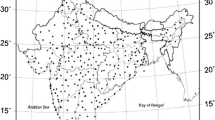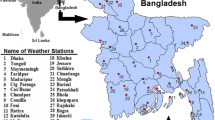Abstract
CSEOF analysis is conducted on the daily mean, maximum, and minimum temperatures measured at 60 Korea Meteorological Administration stations in the period of 1979-2014. Each PC time series is detrended and fitted to an autoregressive (AR) model. The resulting AR models are used to generate 100 sets of synthetic PC time series for the period of 1979-2064, and the linear trends are added back to the resulting PC time series. Then, 100 sets of synthetic daily temperatures are produced by using the synthetic PC time series together with the The cyclostationary EOF (CSEOF) loading vectors. The statistics of the synthetic daily temperatures are similar to those of the original data during the observational period (1979-2064). Based on the synthetic datasets, future statistics including distribution of extreme temperatures and the length of four seasons have been analyzed. Average daily temperature in spring is expected to decrease by a small amount, whereas average temperatures in summer, fall and winter are expected to increase. Standard deviation of daily temperatures is expected to increase in all four seasons. The Generalized Extreme Value and Generalized Pareto distributions of extreme temperatures indicate that both warm and cold extremes are likely to increase in summer, while only warm extremes are predicted to increase significantly in winter. Thus, heat waves will increase and cold waves will decrease in number in future. Spring and fall will be shorter, whereas summer and winter will be longer. A statistical prediction carried out in the present study may serve as a baseline solution for numerical predictions using complex models.
Similar content being viewed by others
References
Beniston, M., and Coauthors, 2007: Future extreme events in European climate: An exploration of regional climate model projections. Climatic Change, 81, 71–95.
Bonsal, B. R., X. Zhang, L. A. Vincent, and W. D. Hogg, 2001: Characteristics of daily and extreme temperatures over Canada. J. Climate, 14, 1959–1976.
Dwyer, J. G., M. Biasutti, and A. H. Sobel, 2012: Projected changes in the seasonal cycle of surface temperature. J. Climate, 25, 6359–6374, doi:10.1175/JCLI-D-11-00741.1.
Easterling, D. R., J. L. Evans, P. Y. Groisman, T. R. Karl, K. E. Kunkel, and P. Ambenje, 2000: Observed variability and trends in extreme climate events: A brief review. Bull. Amer. Meteor. Soc., 81, 417–425.
Gilleland, E., and R. W. Katz, 2005: Extremes Toolkit (extRemes): Weather and climate applications of extreme value statistics. [Available online at http://www.isse.ucar.edu/extremevalues/evtk.html.]
Griffiths, G. M., and Coauthors, 2005: Change in mean temperature as a predictor of extreme temperature change in Asia -Pacific region. Int. J. Climatol., 25, 1301–1330, doi: 10.1002/joc.1194.
Houghton, J. T., Y. Ding, D. J. Griggs, M. Noguer, P. J. van der Linden, X. Dai, K. Maskell, and C. A. Johnson, 2001: Climate Change 2001: The Scientific Basis. Cambridge University Press, 944 pp.
Jung, H.-S., Y. G. Choi, J.-H. Oh, and G.-H. Lim, 2002: Recent trend in temperature and precipitation over South Korea. Int. J. Climatol., 22, 1327–1337, doi:10.1002/joc.797
Katz, R. W., and B. G. Brown, 1992: Extreme events in a changing climate: Variability is more important than averages. Climatic Change, 21, 289–302, doi:10.1007/BF00139728
Kim, K.-Y., G. R. North, and J. Huang, 1996: EOFs of one-dimensional cyclostationary time series: Computations, examples and stochastic modeling. J. Atmos. Sci., 53, 1007–1017.
Kim, K.-Y., G. R. North, 1997: EOFs of harmonizable cyclostationary processes. J. Atmos. Sci., 54, 2416–2427.
Kim, K.-Y., and Q. Wu, 1999: A comparison study of EOF techniques: Analysis of nonstationary data with periodic statistics. J. Climate, 12, 185–199.
Kim, K.-Y., and J.-W. Roh, 2010: Physical mechanisms of the wintertime surface air temperature variability in South Korea and the near-7-Day oscillations. J. Climate, 23, 2197–2212, doi:10.1175/2009JCLI3348.1.
Kim, K.-Y., B. Hamlington, and H. Na, 2015: Theoretical foundation of cyclostationary EOF analysis for geophysical and climatic variables: Concepts and examples. Earth Sci. Rev., 150, 201–218, doi:10.1016/j.earscirev.2015.06.003.
Kim, Y., K.-y. Kim, and B.-M. Kim, 2013a: Physical mechanisms of European winter snow cover variability and its relationship to the NAO. Climate Dyn., 40, 1657–1669, doi:10.1007/s00382-012-1365-5.
Kim, Y., K.-y. Kim, and J.-G. Jhun, 2013b: Seasonal evolution mechanism of the East Asian winter monsoon and its interannual variability. Climate Dyn., 41, 1213–1228, doi:10.1007/s00382-012-1491-0.
Kim, Y., K.-y. Kim, and S. Park, 2014: Seasonal scale variability of the East Asian winter monsoon an the development of a two-dimensional monsoon index. Climate Dyn., 42, 2159–2172, doi:10.1007/s00382-013-1724-x.
Luterbacher, J., D. Dietrich, E. Xoplaki, M. Grosjean, and H. Wanner, 2004: Europian seasonal and annual temperature variability, trends and extreme since 1500. Science, 303, 1499–1503, doi:10.1126/science. 1093877
Lynch, C., A. Seth, and J. Thibeault, 2016: Recent and projected annual cycles of temperature and precipitation in the Northeast United States from CMIP5. J. Climate, 29, 347–365, doi:10.1175/JCLI-D-14-00781.1.
Mearns, L. O., R. W. Katz, and S. H. Schneider, 1984: Extreme high temperature events: changes in their probabilities with changes in mean temperature. J. Climate Appl. Meteor., 23, 1601–1613.
Meehl, G., C. Covey, T. Delworth, M. Latif, B. McAvaney, J. Mitchell, R. Stouffer, and K. Taylor, 2007: The WCRP CMIP3 multi-model dataset. Bull. Amer. Meteor. Soc., 88, 1383–1394.
Newton, H. J., 1988: TIMESLAB: A Time Series Analysis Laboratory. Brooks/Cole Pub Co, 625 pp.
Parkinson, C. L., 1994: Spatial patterns in the length of the sea ice season in the Southern Ocean, 1979-1986. J. Geophys. Res., 99, 16327–16339.
Robeson, S. M., 2002: Increasing growing-season length in Illinois during the 20th century. Climatic Change, 52, 219–238.
Schär, C., P. L. Vidale, D. Lüthi, C. Frei, C. Häberli, M. A. Liniger, and C. Appenzeller, 2004: The role of increasing temperature variability in European summer heat waves. Nature, 427, 332–336, doi:10.1038/nature02300.
Serreze, M. C., A. P. Barrett, J. C. Stroeve, D. N. Kindig, and M. M. Holland, 2009: The emergence of surface-based Arctic amplification. The Cryosphere, 3, 11–19.
Walsh, J. E., A. S. Phillips, D. H. Portis, and W. L. Chapman, 2001: Extreme cold outbreaks in the United States and Europe, 1948-99. J. Climate, 14, 2642–2658.
Author information
Authors and Affiliations
Corresponding author
Rights and permissions
About this article
Cite this article
Lee, J. Future trend in seasonal lengths and extreme temperature distributions over South Korea. Asia-Pacific J Atmos Sci 53, 31–41 (2017). https://doi.org/10.1007/s13143-017-0002-y
Received:
Accepted:
Published:
Issue Date:
DOI: https://doi.org/10.1007/s13143-017-0002-y




